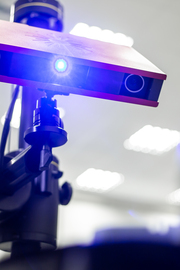Why Schools Should Invest in 3D Scanners for Their Students
The technological landscape around us continues to evolve at a rapid pace. So, it’s no surprise that educators face the challenge of providing students with innovative tools and the skills to use those tools. In particular, 3D scanners are devices that students should learn how to use for a head start. Learn why schools should invest in 3D scanners for their students here.
Accustoms Students to the Devices of the Future
Integrating 3D scanners into the classroom setting does more than just impart technical skills; it accustoms students to the devices of the future. As industries continue to adopt 3D technologies, such as manufacturing and healthcare, the presence of these technologies in the job market grows exponentially.
By familiarizing students with 3D scanners, schools create an environment where young minds can learn and become proficient with the same tools they will encounter in their future careers. This foresight in education enhances a student’s adaptability. Additionally, it increases their marketability as they enter a workforce that highly values tech-savvy individuals.
It’s Not Just 3D Scanners
3D scanners aren’t the only innovative devices your school should introduce to students for their future technical savvy. Virtual reality is another rapidly advancing technology that is already becoming part and parcel of everyday life.
Fortunately, virtual reality helps education in more ways than just exposing students to the tech. Incorporate it alongside 3D scanners to produce the most well-rounded, prepared students you can.
Enhances Learning for Students Interested in STEM
For students with aspirations in science, technology, engineering, and mathematics (STEM) fields, 3D scanners serve as a pivotal educational resource. In fact, one of the key uses of 3D scanning technology in schools is catering to and fostering interest in STEM fields.
These devices allow for the conversion of any object into a digitized model that students can manipulate, study, and analyze. This brings abstract concepts to life. Hands-on experience with advanced technology deepens students’ comprehension and sparks an interest in complex subjects.
The resulting versatility in experiments and projects rockets STEM education from the confines of textbooks into the tangible world. It provides a more comprehensive learning experience that can accommodate many learning styles.
Fosters Student Creativity and Curiosity
Finally, 3D scanners play a significant role in fostering student creativity and curiosity. When students can scan objects and manipulate them within a virtual space, they are encouraged to explore a multitude of design possibilities.
This exploration goes beyond mere novelty; it teaches students to think critically about the design and function of everyday objects. It challenges them to invent, innovate, and solve problems in creative ways. By creating space in the classroom for this type of inquisitive and inventive thinking, schools are equipping a new generation of thinkers, creators, and problem-solvers. It empowers the children of today to better face the challenges of the future.
The potential that 3D scanners hold for enhancing education is immeasurable, making it clear why schools should invest in 3D scanners for their students. By helping students seamlessly interact with future technologies, strengthening their grasp on STEM disciplines, and nurturing a creative and problem-solving mindset, 3D scanners act as a catalyst for an immersive and future-forward education.





